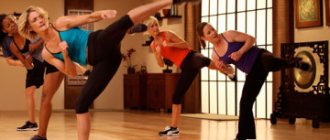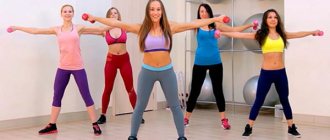What is metabolic strength training?
Let's first look at what this type of training actually is.
So, metabolic training for weight loss is a scheme that includes several types of exercises performed at very high intensity with minimal rest breaks. This is done in order to create a feeling of oxygen starvation.
After performing several metabolic exercises on different muscle groups, you can take a short break and then begin again on another muscle group.
This type of training combines several other types at once, for example, high-intensity strength and aerobic.
Ideally, you will work so intensely that your body goes into a state of oxygen starvation from intense exertion. And this state will allow you to burn calories even after training.
MFR exercises
Myofascial release is a variety of exercises to work different areas of the body:
- For the upper back. To relax the muscles, we lie down on a special roller. The body should be suspended - it is important to maintain the correct position. We place our hands on the chest. In this position, we begin to move slowly, slowly, rolling the machine with our backs. It should reach its middle, then return back. If during the rolling process a serious source of pain is found, we treat the problem area until you feel relief.
- For the tibial muscles. The exercise is performed from a position - lying on your stomach. A special roller is placed in the groin area. Roll it slowly. We move from top to bottom.
- For the popliteus muscle. We sit on the floor. We lean on the surface from behind with our hands. We place the roller under the knees. The body must be suspended. We roll the simulator back and forth.
Interesting fact. MFR or myofascial analysis – rapid recovery from excessive stress, as well as excellent prevention in case of injury. These workouts can be easily implemented at home, which is another significant advantage.
If you are interested in different types of programs for pumping muscles with minimal risks of injury, we suggest visiting other sections of our website. Here you will find interesting activities, as well as answers to many questions, for example, “why muscles hurt after training.” Stay with us - it will only get more interesting.
Aerobic and anaerobic exercise
So, when you exercise too intensely, your body experiences an “excess” of oxygen consumption.
This brings us to the part about the difference between aerobic and anaerobic exercise.
Aerobic exercise is usually performed in the presence of normal oxygen levels and gets you moving but does not greatly increase your heart rate.
Anaerobic exercise, on the other hand, is performed in a state of oxygen deprivation, this happens because you are training so intensely that your body needs more and more air to cope with the workout. This is how the effect of oxygen starvation occurs.
This causes the body to begin consuming excess amounts of oxygen in an attempt to recover.
This process helps boost your metabolism to a high level, hence the term “metabolic training.”
For a workout to be considered metabolic it must meet three criteria:
- Engage all parts of the body
- Run at maximum intensity level
- Cause a burning sensation, which means the production of lactic acid in muscle tissue
Why Qubo is a completely new approach to training
12.01.2018
Equipment from Qubo3 appeared on the fitness market relatively recently (only three years ago), but during this time it has already managed to win fans around the world. Qubo balancing equipment has no analogues. What is the secret of his popularity?
1. MULTIFUNCTIONAL Qubo equipment, depending on the type of training and the goals set (to lose weight or pump up core muscles), can be used by both trained athletes and beginners. Qubo has a positive effect on the vestibular system, helps develop strength, improves posture, coordination, flexibility, and strengthens the core muscles. — The balancing pillow can be used during Pilates and stretching classes, for a relaxing massage. — Functional training can be carried out in different formats: individual training, mini class, group lesson — In addition, Qubo goes well with the main strength program, it can be used for exercises with a barbell, dumbbells, bodybar, loops.
2. SIMPLICITY Despite the fact that the Qubo balance pad looks unusual, you don’t need any special preparation to practice with it. For example, the training program for the development of functional strength and balance #OliveRivolution is built in the format of increasing sequences, starting from a simple level and ending with an advanced one. The program consists of separate blocks of exercises, by combining which the instructor can independently build a lesson taking into account the level of training of his clients.
3. EFFECTIVENESS AND ATTRACTIVENESS Training with the Qubo balance pad arouses genuine interest among clients because, first of all, it is effective. Modern exercise machines are able to provide correct biomechanics when performing exercises, which allows you to achieve tangible results quite quickly. However, Qubo's unstable surface makes classes much more effective because, among other things, you have to maintain your balance. This uses stabilizer muscles that are not worked during regular strength training. In addition, bright equipment is also pleasant from an aesthetic point of view (by the way, Qubo3 equipment is branded in the corporate colors of the fitness club - a definite plus from a marketing point of view).
4. SAFETY All Qubo3 brand products are safe for health. The PlastiQ material, created on the basis of its own developments, has a number of distinctive features: being hypoallergenic, it does not cause irritation even when in contact with the most delicate skin. Moreover, the material has antiseptic properties. In addition, it is very durable and can withstand loads of up to 600 kg, and, accordingly, has a long service life.
A little deeper into the essence of the approach
So, MCTs include parts of strength training and metabolic training. In other words, this means you perform complex strength workouts back to back with little or no breaks.
These factors satisfy all of the above criteria. You're engaging multiple muscle groups, working close to your limits, and thanks to the high intensity, you're definitely promoting lactic acid production.
How is this workout different from others?
You can see a little comparison here
| Meta-sky | Power | Metcon | Cardio | Crossfit | HIIT | |
| High intensity | YES | MAYBE | YES | NO | MAYBE | YES |
| Working against resistance | YES | YES | NO | NO | SOMETIMES | NO |
| Short rest intervals | YES | NO | YES | NO | SOMETIMES | YES |
| Anaerobic | YES | YES | YES | NO | SOMETIMES | YES |
| Includes both strength and cardio exercises | YES | NO | NOT ALWAYS | NO | YES | NO |
So, from the table above you can see that MCT gives the maximum result.
Unlike other types of training, it not only improves your strength and cardiovascular system, but also gets you in shape in a fairly short period. Proper metabolic strength training lasts 20 to 30 minutes on average.
Let's compare this to a regular workout (strength or cardio), which lasts about 45 minutes. Or even training in the gym, yes, they are all effective, but most people with today’s pace of life simply don’t have time, so MCT is the best option for them.
MFR
Continuing the “massage” theme, we can also recall MFR training. Their full name is myofascial release. This type of exercise draws the attention of athletes to fascia - this is connective tissue, the lining of internal organs, blood vessels, and also muscles and tendons, which is more interesting with MFR. Using rollers with either a smooth or ribbed surface, as well as double and single balls, the fascia is kneaded (it is known that with age they lose elasticity). As a result, the “rigidity” of movements disappears, the sliding of muscle layers improves. The massage effect also helps remove muscle tension. The body becomes more flexible. In professional sports, MFR often serves as a cool-down, but at the same time it can also be a separate type of training.
Who is MST suitable for?
Now you already have at least some idea about metabolic training, now let's discuss who it is suitable for.
Honestly, they are suitable for everyone, but they should definitely be preferred by those who want:
- not long but effective workouts
- burn fat and develop muscle as quickly as possible
- have developed muscles, but at the same time remain slim
- improve the cardiovascular system
- don't waste time on long workouts
- look athletic and attractive
- expose yourself and your body to new tests
From all this it is clear that such training can improve everyone's life.
There are only a few types of people who should avoid MCTs
People recovering from injury should not start MCT. Firstly, metabolic training requires high intensity and if you do it half-heartedly, there will be no result. Secondly, such high intensity can damage the injury and worsen your current condition. Thus, it is better to wait for complete recovery and only then start training.
The next people who should avoid MCT are beginners. If you are just starting your sports “path”, then it is better to start with something else. The fact is that your body is not prepared for such high intensity. Therefore, for now it is better to prepare the body for such loads, it will take about 6 months (maybe longer, it all depends on you)
Well, the third group is people with certain diseases. For example, if you have heart problems, then MCT is simply contraindicated for you and it is better to give preference to moderate-intensity training.
Pregnancy is also a stop sign for MCT. If you still have questions, it is best to discuss them with your coach.
Before we dive into what metabolic training actually looks like, let's first talk about its benefits.
So here are some key points:
Accelerated fat burning process
It is an indisputable fact that compared to conventional strength training, metabolic training is significantly superior.
During several studies, scientists found that, unlike training at a moderate pace, training at a high intensity showed simply crazy results.
The second type burned much more fat than the first.
Moreover, we all know that excess fat can lead to very disastrous consequences, so MCT not only makes you slimmer, but also saves you from various diseases.
Improves fitness and your cardiovascular endurance
As mentioned above, metabolic training makes the heart work faster, due to the high intensity, your heart rate increases, and very short breaks do not allow it to calm down. What
That is why this type of training is not suitable for people with heart problems.
MCT develops muscles and strength
Since MCT also includes strength training, you will also get great results in the muscle area.
And this is another advantage of metabolic strength training, because most other workouts that are aimed at accelerating metabolism do not pay attention to muscles and muscle mass.
Doesn't take much time
As mentioned above, MCT is the fastest and most convenient type of training. You can be at home or in the gym, it doesn’t matter, all you need is 30 minutes of time. And this is very convenient, especially for people with a busy schedule.
Moreover, MCT includes a variety of compound exercises that work the entire body, so 3 workouts per week (one day apart) will make a great workout regimen.
Yes, yes, you don’t have to go to the gym 5 times a week, training individual parts of the body, or include additional cardio exercises in your schedule, because MCT is the best part of both workouts.
Improves insulin sensitivity
Sensitivity is an important factor that not only helps your body control weight, but also prevents the risk of diabetes.
And here MST also managed to succeed. After each workout, your body begins to respond better and better to insulin.
In one experiment conducted by a group of researchers, it was noticed that volunteers who did high-intensity workouts literally showed better insulin sensitivity after a couple of weeks.
Reduces stress levels
Intense exercise also reduces stress levels and improves your mood.
Once you start doing MCTs, you will immediately notice how positively they affect your mood.
With each workout you will feel calmer and more relaxed.
Improves sleep quality
Last but not least, MCT, like any workout, improves the quality of your sleep.
BUT! It is important to choose the right time for your workout, because if you do it too early, you may fall asleep at the wrong time, or, conversely, if you practice too late, you will have more problems falling asleep than usual.
And these are all just the main advantages of this training, so you really should pay attention to this type of training.
Dynamic full body workout. Maximum muscle growth in just 3 days a week
Most young men and middle-aged men who visit gyms and sports clubs most of all want to increase their pectoral muscles, the volume of their arms and to have sculpted abs. They want to be muscular and lean, but don't know how to achieve it. If you have tried many methods and techniques, but they have not brought you the desired result, then most likely there is one important point that you have overlooked. This is the time when the muscle is in a state of tension and is the key to accelerating protein synthesis and muscle growth. With dynamic full-body training that's based on the latest scientific discoveries, you'll be transforming your body in no time!
While it's a known fact that high loads and slow reps build strength, doing a few sets of moderately heavy weights (up to 80% of your 1-rep max) promotes muscle hypertrophy. However, new scientific research recommends using light weights to increase muscle growth, at least for those who exercise for health. This may not be the best method for increasing strength, but it is a safe, effective and fast way to gain muscle mass and reduce body fat.
Metabolic stress is key to building muscle mass and reducing fat. Sophisticated studies that measured rates of protein synthesis and gene activation found that high-volume training using moderate weights had a greater impact on muscle protein synthesis than programs using heavy weights and slow repetitions. High training volume creates metabolic stress, which promotes muscle growth and activates genes that control protein synthesis, as well as stimulating hormones that help break down fat.
The amount of time a muscle is under tension (the total time it takes to make a series of muscle contractions) is critical to building muscle mass. Using heavy weights and low reps puts a lot of stress on the muscles, but it doesn't last long. Training with moderately heavy weights to increase volume and minimizing rest periods between sets maximizes metabolic stress, increases growth hormone levels, and activates biochemical processes that lead to increased muscle size.
Dynamic training uses the latest scientific advances in sports medicine to quickly and effectively build muscle and reduce fat stores. To do this, based on complex electromyographic studies, exercises were selected that are the best for growing and strengthening muscles in the shortest possible time. Exercise patterns and rest intervals maximize the release of powerful hormones such as testosterone, IGF-1 and growth hormone, which promote muscle hypertrophy and fat loss.
Dynamic training maximizes the amount of time a muscle is under tension using moderate loads (50 to 80% of 1RM), high volume (8 to 12 reps), and low tempo (6 seconds lifting and 6 seconds lowering the weight). . The training program uses supersets with short rest breaks between sets to shorten the time and push the muscles to grow as much as possible.
Supersets are one of the best ways to build muscle in the shortest possible time. Exercises are combined in pairs that target key muscle groups. Do the first exercise, followed immediately by the second, then superset the second time. Rest for one minute, then perform the next pair of exercises in the same way. Supersets involve working a certain muscle group, then working another muscle group, which gives the previous one a chance to rest.
Supersets meet the most important conditions for muscle growth - a high degree of tension is maintained for a long time. By the end of this short but intense workout, your legs, shoulders, arms and abs will have received maximum strength. Hard work not only builds muscle, but it also burns a lot of calories during and after your workout.
With dynamic muscle tension, a slow pace of exercise is used - about 6 seconds to lift and lower the weight. Even one set of 8 repetitions performed can cause temporary muscle wasting and trigger chemical reactions that lead to rapid muscle hypertrophy. Various studies by Canadian and Australian scientists have found that training to failure using light weights leads to more muscle protein synthesis than the same training, but with heavier weights and fewer repetitions. Lighter weights allow people to do more repetitions throughout their workout. It has also been found that using light weights combined with a high volume of work increases muscle growth for 24-30 hours after training.
Training
Perform the exercises in each superset without stopping, resting for 1 minute between supersets. For example, do one set of front squats and one set of back squats, then rest for 1 minute and perform the next superset (leg curls) in the same way. Perform each repetition slowly and under control—6 seconds to lower and 6 seconds to rise. Use light weights that are approximately 50-60% of your rep max. For best results, drink a protein shake after your weight training, do 30-60 minutes of aerobic exercise 3-5 times a week, and reduce your food intake by approximately 200 calories per day.
Training program.
| Exercise | Sets | Repetitions |
| Superset 1 | ||
| Front Squats | 2-3 | 8-12 |
| Squats with a barbell on your shoulders | 2-3 | 8-12 |
| Superset 2 | ||
| Bent-over dumbbell row | 2-3 | 8-12 |
| Bench press | 2-3 | 8-12 |
| Superset 3 | ||
| Leg extension in the simulator | 2-3 | 8-12 |
| Leg bending in the simulator | 2-3 | 8-12 |
| Superset 4 | ||
| Seated dumbbell press | 2-3 | 8-12 |
| Sitting dumbbell raises | 2-3 | 8-12 |
| Superset 5 | ||
| Scott Bench Curl | 2-3 | 8-12 |
| Barbell Arm Extension (French Press) | 2-3 | 8-12 |
Based on materials from FitnessRXforMen magazine
Translation and adaptation: Vyacheslav Kazantsev
Metabolic Workout Example
So how do you properly structure all of your exercises? Yes, and in general, what is MST?
Below you will find one possible example for your training. The training cycle can be up to three times, it all depends on your qualifications and athletic training.
The exercises are performed one after another. But for beginners, it is better to choose a couple of exercises from this list, adding them as their abilities develop.
Well, or you can change and rearrange these exercises to make it more comfortable for you.
Rest should be minimal. For beginners, about 1-2 minutes, but for more advanced athletes, the break should be no more than 20 seconds.
For exercises that require weight, choose the heaviest possible object to keep you toned. So here are some rules that may help you:
- First lap: 70% of your maximum ability
- Second circle: 80%-90% of maximum
- Third lap: 90%+ of maximum
Set of exercises
- Squats, 10-20 times
- Lunges 10 times on each leg
- Jumping lunges 10 times on each leg
- Squats with jumps 10 times
- Single toe touches, 8-15 reps
- Fitball crunches 10-15 reps
- Leg raises using a fitball 10-15 reps
- Press 10-12 times
- Press using a fitball 10-20 reps
- Push-ups on the ball 10-20 times
- Pull-ups (until exhaustion)
- Lifting dumbbells (butterfly) 10-20
- Raising dumbbells forward 10-20 reps
- Triceps exercise with weight (cable rope), 10-20 repetitions
Features of interval programs
Interval training is a program that alternates between high and moderate exercise. It is believed that such alternation gives maximum results, since it best develops endurance. In addition, interval programs are called the most effective for weight loss.
For beginners, interval training may seem like an excessive load, so you should start such training only under the supervision of an experienced instructor who will monitor how your body reacts to alternating loads. It is recommended to first consult with a sports physician, especially if there are problems with the cardiovascular system.
Alternating high and moderate loads
You can include absolutely any exercises in the interval program, because the main feature here is not specific loads, but their alternation. Therefore, the complex can be adapted to suit you. For example, training may include a strength and speed program, or running and abdominal exercises. The main thing is the intensity of the work.
How to Add Metabolic Circuitry to Your Training Process?
So, how to properly plan such a workout?
You should remember that this approach to exercise forces the whole body to work, which is why it is better that both before and after training you have a day off from other types of training.
Yes, of course, you can do some cardio exercises, but they should be light enough so as not to overtax the body. After all, doing two intense workouts in a row can lead to injury or other unpleasant consequences.
REMEMBER! The body must have enough time to recover.
If you don't want to exclude strength training from your sports regimen, then it's worth adding MCT so that you have rest before and after it.
Don’t forget, this workout puts a lot of stress on your body, so don’t forget about the rest that your body will need so much.
And running is not the best way to relax and get away from MST, it’s better to take care of yourself, watch movies, take a relaxing bath. Whatever, just let your body recover and only then proceed to the next workout.
Sleep and recovery are just as important as training and nutrition itself.
Rest is the most underrated element of training. No matter how long you endured the pain of those last reps or how diligently you sourced protein and calories from your diet, it's not as important as the time it takes for nutrients and hormones to promote muscle protein synthesis after exercise.
Exercise and food are an important part of the muscle growth equation, but they're not the whole story. Adequate recovery is very important - it is necessary to give the muscles enough time to replenish glycogen stores and undergo the processes of reconstruction and creation of new muscle tissue.
The recovery required for muscle growth is 48–72 hours between training sessions for a particular muscle group. This scientific argument, by the way, speaks in favor of split training - when each muscle group receives the main load, for example, once a week.
Inducing mechanical and metabolic stress during your gym training will only make sense while the hormones and substances necessary for muscle growth are released during REM sleep. This means that a full night’s sleep is important for muscle growth after training. Inadequate sleep and recovery will ruin your efforts in the gym and at the dinner table. Moreover, lack of sleep can increase adrenaline and cortisol levels, which can also reduce the ability to form new muscle tissue.
Lack of sleep, poor appetite, long-term illnesses, and loss of growth as a result of exercise are all symptoms of overexertion that can significantly impact a person's ability to achieve their fitness goals.
“Underrecovery” is another reason to think about overexertion. “To promote muscle growth, you need time for rest (active rest) to allow for full recovery,” says Schoenfeld (2013).
Training program for gaining muscle mass
Number of repetitions
Science suggests that for maximum muscle growth, select the weight so that you do 8-12 repetitions until muscle failure - it’s good that almost every trainer in the gym seems to know this simple fact. True, now, unlike you, not everyone knows why exactly.
Amount of rest between sets
Short to moderate rests between sets (30 seconds to 2 minutes) can cause significant metabolic stress.
Number of approaches in each exercise
According to scientists, performing 3-4 approaches provides the most effective mechanical tension for all muscles involved.
Travel speed
Scientists recommend performing movements with maximum effort faster - 1-2 seconds (for example, lifting a barbell), and the eccentric phase of the exercise (for example, lowering a barbell) for a longer period (2-6 seconds). Slower execution of the eccentric phase is necessary to ensure sufficient mechanical tension - it is this “easier” phase of movement that is most important for muscle growth. “From a hypertrophy perspective, eccentric contraction has a greater impact on muscle development. In particular, eccentric exercise has been associated with greater increases in protein synthesis” (Schoenfeld, 2010).
Free weights or machines
Scientist Schoenfeld argues that each type of resistance plays a role in optimal muscle growth: "Free weights, which involve a large number of muscles, help increase muscle density, while the stabilization provided by machines allows for greater loading of individual muscles."
Preparing for serious training
When training for muscle growth with a large metabolic and mechanical effect, it can cause serious muscle damage and is recommended for people with at least one year of training experience.
It is necessary to start with a dynamic warm-up, loading the core muscles (abs, stabilizer muscles and others) to prepare the muscle tissue for the stress of high-volume training.
Exercise order
It is preferable to start training with complex movements with free weights to engage the maximum number of muscles (for example, squats with a barbell, deadlifts are best done at the beginning of training), and during the course of the session gradually move on to machines that affect individual muscles.
Extreme exercise
The last exercise in each workout must be performed in a weight-loss machine: after all repetitions of the approach to failure, the weight is reduced and the maximum possible number of repetitions must be done with it until failure.
Weight loss approaches can cause significant mechanical and metabolic stress, as well as significant discomfort, and should be performed at the end of the session.
Excessive load
It is important to dose the load that is necessary for you, because “overload” can be no less harmful to muscle growth than “underload.” For example, in the program recommended by scientists for muscle growth (see below), cardio load is limited. According to Schoenfeld, "too much energy expenditure can reduce muscle growth."










